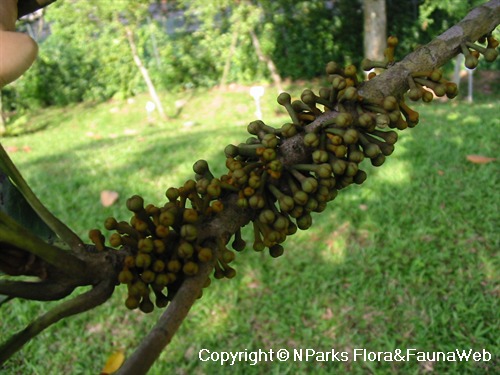
Back
Palaquium obovatum (Griff.) Engl. var. obovatum
| Family Name: | Sapotaceae |
| Synonyms: | |
| Common Name: | Nyatoh Puteh, White Gutta, Nyatoh Putih, Nyatuh, Taban Puteh, Taban Balam Kuning |
Name
Classifications and Characteristics
| Plant Division | Angiosperms (Flowering Seed Plants) (Dicotyledon) |
|---|---|
| Plant Growth Form | Tree (Big (>30m)) |
| Lifespan (in Singapore) | Perennial |
| Mode of Nutrition | Autotrophic |
| Plant Shape | Irregular |
| Maximum Height | 40 m |
Biogeography
| Native Distribution | From India to Myanmar, Thailand, Indochina, Sumatra, Peninsular Malaysia, Singapore, and Borneo |
|---|---|
| Native Habitat | Terrestrial (Primary Rainforest, Secondary Rainforest, Coastal Forest, Freshwater Swamp Forest) |
| Preferred Climate Zone | Tropical |
| Local Conservation Status | Native to Singapore (Vulnerable (VU)) |
Description and Ethnobotany
| Growth Form | It is a tree up to 40 m tall with a rather cylindric crown. It produces sticky, copious latex. |
|---|---|
| Foliage | Its spirally arranged, long-stalked leaves have almost leathery leaf blades that are usually drop-shaped, 14–30 by 6.4–15 cm, and characteristically dark brown when dried. |
| Flowers | Its stalked flowers are 1–2 cm long, covered with brownish hairs, and found along the twigs behind the leaves. The flowers emit a strong smell of musang, sour milk and burnt sugar. |
| Fruit | Its fruits are round, up to 2.5–3 cm wide, and contain 1–2 seeds. Its seeds are compressed oval and up to 2 by 1.8 cm. |
| Habitat | It usually grows in limestone forests, and other types of lowland forests. It occurs locally along the Dragon Trail (Sentosa), in Nee Soon Swamp Forest, Lazarus Island, and Pulau Pawai. |
| Associated Fauna | Its flowers are insect-pollinated. It is also the preferred local food plant for caterpillars of the butterfly, the Malay viscount (Tanaecia pelea pelea), the adult of which usually lays its eggs at the centre of the underside of the mature leaf blade. |
| Cultivation | It can be propagated by seed. |
| Etymology | Latin Palaquium, from the Filipino name of the plant, palak-palak; Latin obovatum, obovate or drop-shaped, referring to the shape of the leaf blades |
| Ethnobotanical Uses | Timber & Products: The timber is durable under water, and so used in building houses and planking boats. Cultural / Religious: Heritage Tree : There are currently three individuals of Palaquium obovatum listed as Heritage Trees in Singapore. One can be found on Sentosa and two at Singapore Botanic Gardens. To find out more about these trees, please visit the Heritage Tree Register. Others: A low quality form of natural rubber was also made using the latex produced. |
Landscaping Features
| Landscaping | It may be suitable for parks and roadsides. |
|---|---|
| Desirable Plant Features | Fragrant (Flowers) |
| Landscape Uses | General, Suitable for Roadsides, Parks & Gardens, Small Gardens, Coastal |
Fauna, Pollination and Dispersal
| Fauna Pollination Dispersal Associated Fauna | Butterfly Host Plant (Leaves) |
|---|---|
| Pollination Method(s) | Biotic (Fauna) |
| Seed or Spore Dispersal | Biotic (Fauna) |
Plant Care and Propagation
| Light Preference | Full Sun |
|---|---|
| Water Preference | Moderate Water |
| Plant Growth Rate | Moderate |
| Rootzone Tolerance | Moist Soils, Well-Drained Soils, Fertile Loamy Soils |
Foliar
| Foliage Retention | Evergreen |
|---|---|
| Mature Foliage Colour(s) | Green |
| Mature Foliage Texture(s) | Leathery |
| Foliar Type | Simple / Unifoliate |
| Foliar Arrangement Along Stem | Alternate, Spiral |
| Foliar Attachment to Stem | Petiolate |
| Foliar Shape(s) | Non-Palm Foliage (Obovate) |
| Foliar Venation | Pinnate / Net |
| Foliar Margin | Entire |
| Leaf Area Index (LAI) for Green Plot Ratio | 3.0 (Tree - Intermediate Canopy) |
Floral (Angiosperm)
| Flower & Plant Sexuality | Bisexual Flowers |
| Flower Colour(s) | Brown, Cream / Off-White |
|---|---|
| Flower Texture(s) | Hairy / Hirsute |
| Flower Grouping | Cluster / Inflorescence |
| Flower Location | Cauliflorous |
Fruit, Seed and Spore
| Fruit Classification | Simple Fruit |
|---|---|
| Fruit Type | Fleshy Fruit |
Image Repository
Others
| Master ID | 1755 |
|---|---|
| Species ID | 3048 |
| Flora Disclaimer | The information in this website has been compiled from reliable sources, such as reference works on medicinal plants. It is not a substitute for medical advice or treatment and NParks does not purport to provide any medical advice. Readers should always consult his/her physician before using or consuming a plant for medicinal purposes. |












_lowres.jpg)
